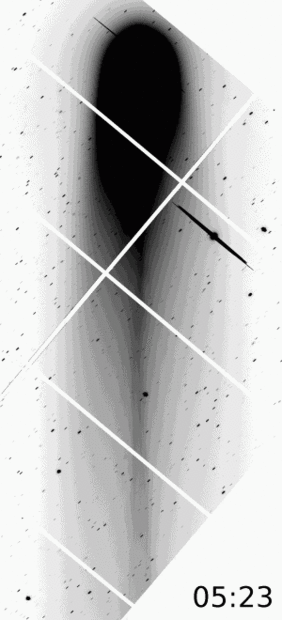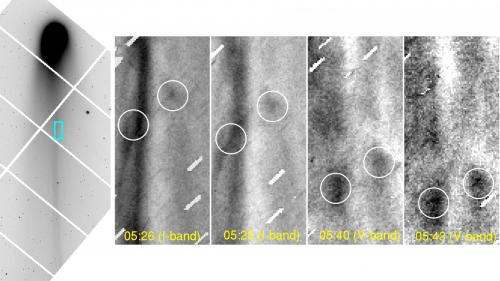
Team of researchers from National Astronomical Observatory of Japan, Stony Brook University (The State University of New York) and Tsuru University reported highly resolved find details of this comet captured in B-band in 2013 (Subaru Telescope's Image Captures the Intricacy of Comet Lovejoy's Tail). They used I-band filter which includes H2O+ line emissions and the V-band filter which includes CO+ and H2O+ line emissions. During the observations, the comet exhibited very rapid changes in its tail in the course of only 20 minutes (Figure 1). Such extreme short-term changes are the result of the comet's interactions with the solar wind, which consists of charged particles constantly sweeping out from the Sun. The reason for the rapidity of these changes is not well understood.
Dr. Jin Koda, the principal investigator of these nights, says "My research is on galaxies and cosmology, so I rarely observe comets. But Lovejoy was up in the sky after my targets were gone on our observing nights, and we started taking images for educational and outreach purposes. The single image from the previous night revealed such delicate details along the tail it inspired us further to take a series of images on the following night. As we analyzed the images, we realized that the tail was displaying rapid motion in a matter of only a few minutes! It was just incredible!"
The plasma tail of a comet forms when gas molecules and atoms coming out from the comet encounter the solar wind. Changes and disturbances in the solar wind can affect the behavior and appearance of this plasma tail, causing it to form clumps of ionized material. The material in the plasma tail departs from the comet's coma and floats away on the solar wind. At these times, the plasma tail can take on a "kinked" or twisted look.
Comment: So says 'conventional cometary science'. Yet as the Rosetta mission showed last year in relation to comet 67P/Churyumov-Gerasimenko, scientists are already discovering new information that is significantly altering their understanding of comets.
"Yet new information is already pouring in. What scientists have discovered is already starting to transform our understanding of Rosetta's target comet, 67P/Churyumov-Gerasimenko (C-G for short), and cometary science."
1. C-G looks nothing like we'd expectWheres the ice 3 surprising comet facts we've already learned from Rosetta
2. The surface is hotter than we guessed, and surprisingly ice-free
3. Despite its dry surface, C-G expels an astronomical amount of water... but not on its dark side
A good candidate for a detailed study of activity in the plasma tail must be a bright comet with an orbit that takes it close enough to the Sun to form such a tail. In addition, the best viewing angles for astronomers to capture views of plasma tail changes occur when the comet also approaches close to Earth. As a result, comets that allow good viewing of the plasma tail are relatively rare - about one or two per year. During its passage, Comet Lovejoy's plasma tail was almost perpendicular (83.5 degrees) to the line of sight from Earth. That made it a prime candidate for close-up observations of its plasma tail structure using Suprime-Cam.

Comment: Could be that the 'speed' differences are due to varying rates of 'electrical discharge'?
The speed of the solar wind ranges from 300 to 700 kilometers per second and the wind intensity and velocity that the comet encounters depends on where it is located with respect to the Sun. The solar wind helps to accelerate the clumps in the tail out away from the Sun. Eventually the clumps in the comet's tail reach this high speed. The observation team thinks they witnessed the beginning of the acceleration of the clumps by the solar wind.
It is still under study how these ion clumps form and what parameters determine the initial speed of them. Dr. Masafumi Yagi, the first author of the paper noted "Comets are often observable only during the twilight as they come near the Sun. On the other hand, it becomes difficult to observe faint objects like galaxies during the twilight hours because of the brighter sky background. Well-designed telescope scheduling like this case makes an effective use of the Subaru Telescope's time and will enable us to collect more data of comets when the opportunity arises in the future."
More information: "Initial speed of knots in the plasma tail of C/2013 R1(Lovejoy)." Masafumi Yagi et al. 2015 The Astronomical Journal 149 97 DOI
Saito et al. 1987, "Structure and dynamics of the plasma tail of comet P/Halley. I - Knot event on December 31, 1985", Astronomy and Astrophysics, 187, 209.
Niedner 1981, "Interplanetary gas. XXVII - A catalog of disconnection events in cometary plasma tails", Astrophysical Journal Supplement Series, 46, 141.
Journal reference: Astrophysical Journal Supplement, Astronomical Journal, Astronomy and Astrophysics
Provided by: Subaru Telescope



Comment: Mainstream science still clings to its original conceptions about comets, despite increasing evidence coming in from Rosetta (see comment above) and other sources that indicate comets and other such bodies are 'electrical' in nature.
Electric Comet Theory: The Enduring - Yet Downplayed - Mysteries of Comets
The True Origins of Electric Comet Theory
Electric Universe: Where Do Asteroids Come From?